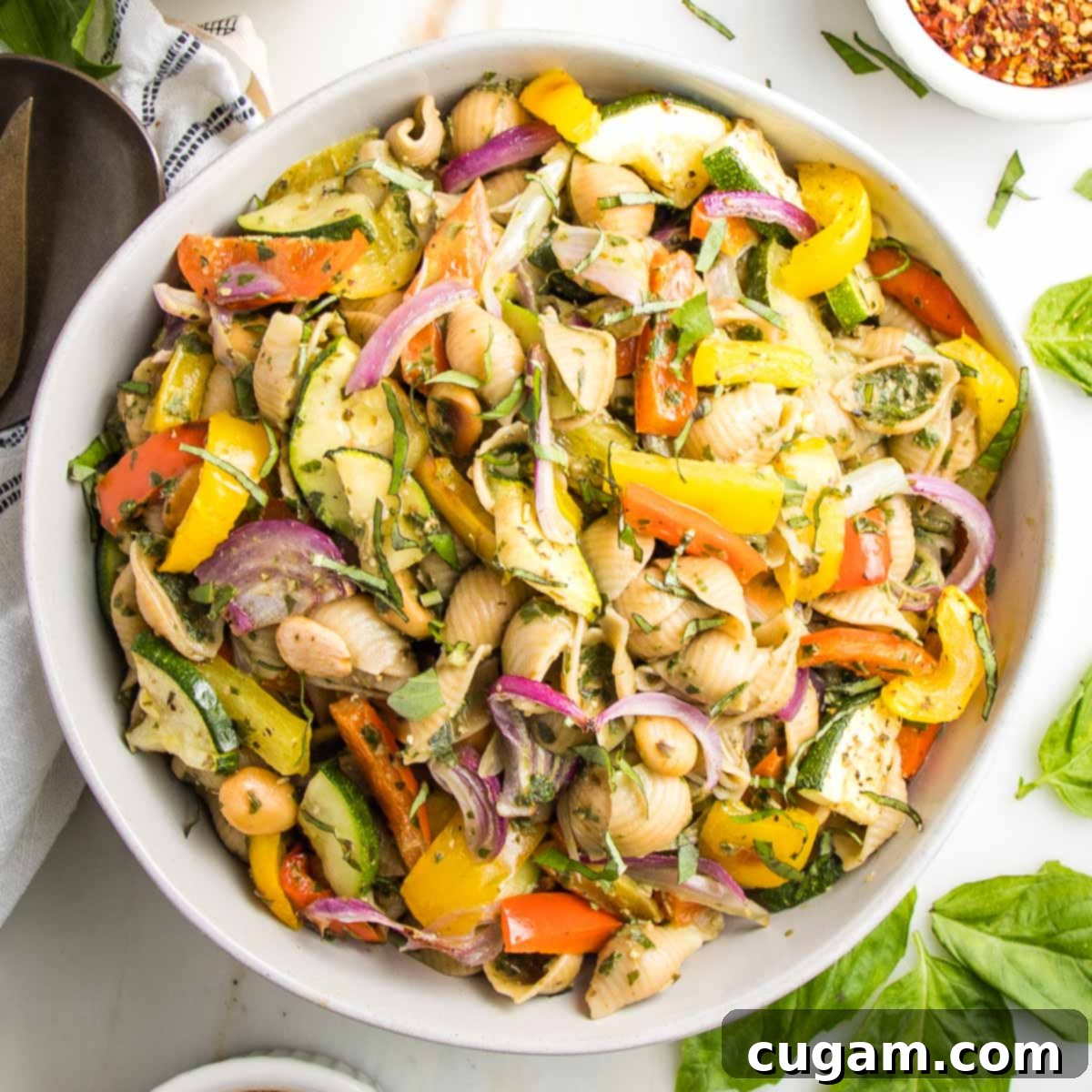Healthy & Easy Roasted Vegetable Pesto Pasta Salad: Your New Go-To Recipe
A truly perfect pasta salad recipe exists, and this Roasted Vegetable Pesto Pasta Salad is it! Imagine a dish that comes together effortlessly in just 30 minutes, brimming with an abundance of delicious, colorful vegetables, and bursting with incredible flavor. Best of all, this recipe is completely without mayonnaise, making it a lighter and fresher option for any occasion. This vibrant pasta salad is destined to become your absolute favorite for every picnic, potluck, summer BBQ, or even as a quick, healthy weeknight dinner. Its delightful taste and ease of preparation will have you coming back to it again and again.
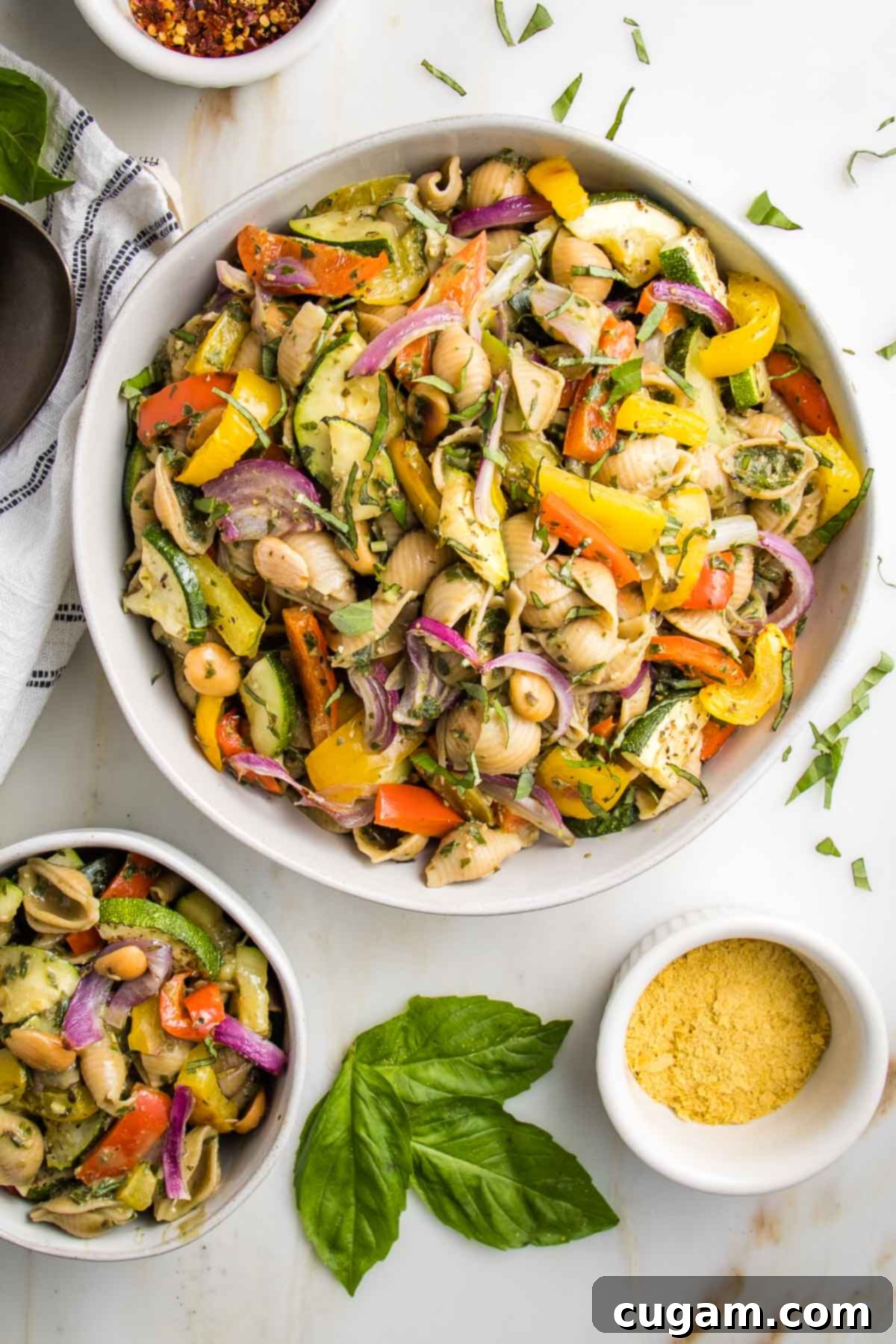
Get ready to embrace your new favorite dish! This super simple veggie pasta salad recipe is a guaranteed crowd-pleaser that everyone will adore. Unlike traditional pasta salads that can sometimes feel a bit heavy or uninspired, this version skips the mayonnaise entirely and introduces so much goodness—not just in taste, but also in texture, visual appeal, and nutritional value. It’s a harmonious blend of flavors and colors that truly sets it apart, making it the star of any table.
Loaded with tender, perfectly roasted vegetables and generously coated in a delicious, homemade dairy-free basil pesto, this salad offers a dreamy combination that is both deeply satisfying and incredibly healthy. It’s adaptable for any season and perfect for every gathering, from casual backyard parties to more formal get-togethers. Prepare to receive rave reviews when you bring this healthy pasta salad recipe to your next event!
Why You’ll Fall in Love with This Pesto Pasta Salad
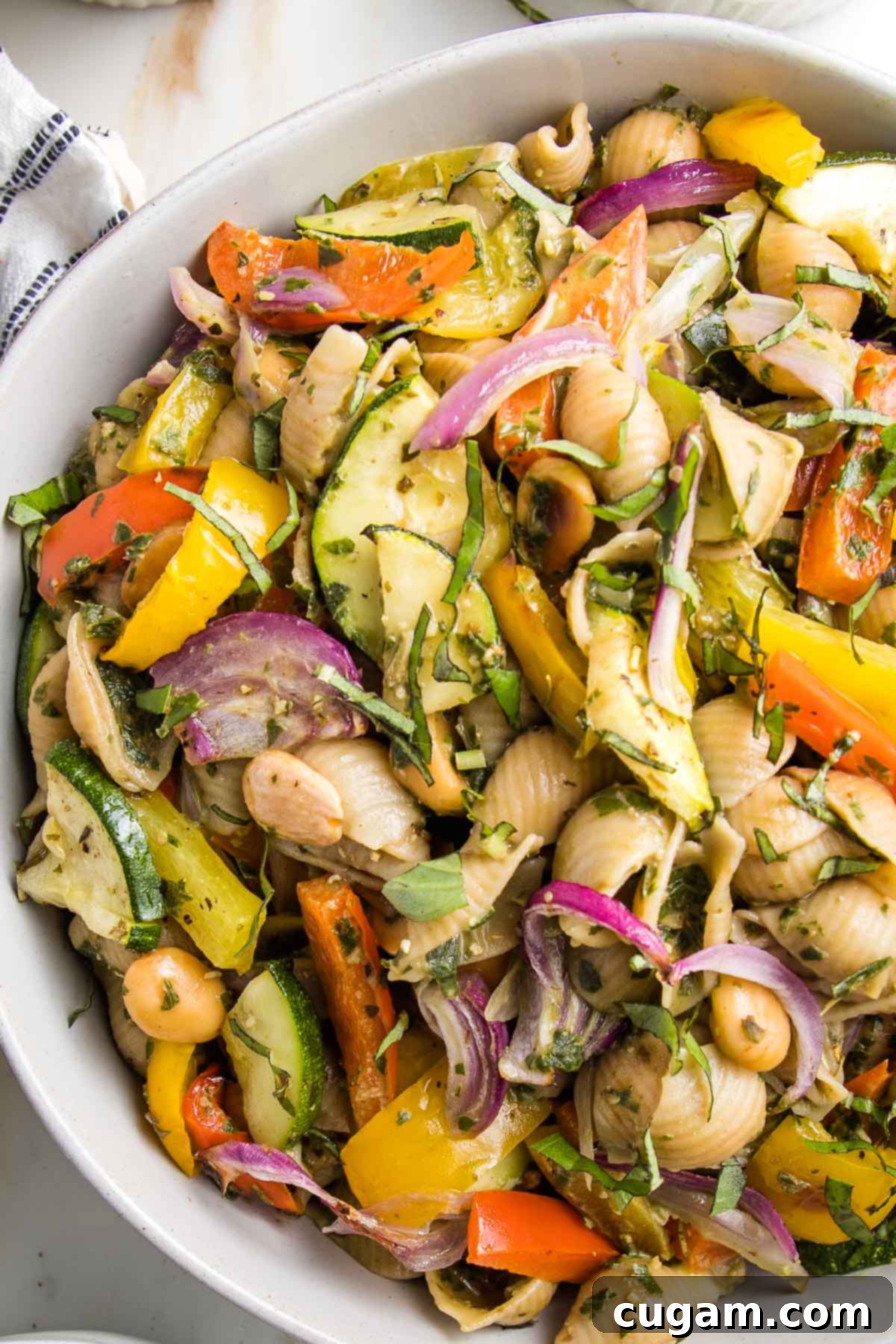
- Visually Stunning: We truly eat with our eyes first, and presentation matters! The medley of colorful roasted vegetables, vibrant green pesto, and your choice of pasta creates a feast for the eyes that’s as appealing as it is delicious.
- Effortlessly Easy: Forget spending hours in the kitchen. This entire dish comes together in just 30 minutes, thanks to efficient roasting and quick pasta cooking. It’s perfect for busy weeknights or last-minute potluck contributions.
- Incredibly Flavorful: The combination of savory, slightly sweet roasted vegetables with aromatic, zesty pesto is a winning one. Every bite offers a delightful explosion of fresh, wholesome flavors that will tantalize your taste buds.
- Meal Prep Perfection: This pasta salad actually tastes even better the next day! You can prepare all or parts of it in advance, making it an ideal candidate for meal prepping. Stored cold, the flavors meld beautifully, offering a convenient and delicious meal ready to go.
- Highly Versatile: Don’t have the exact vegetables on hand? No problem! Use roasted veggies, grilled veggies, or even leftover cooked vegetables. Feel free to swap out the vegetables for whatever is in season or whatever you prefer – the possibilities are endless!
- Truly Healthy: This isn’t just a “pasta salad,” it’s a “vegetable-forward” pasta salad! Notice the generous ratio of veggies to pasta, packed with essential nutrients and fiber. Made with simple, wholesome ingredients, it offers a nourishing meal without compromising on taste.
- Satisfying & Portable Lunch: Looking for a fulfilling lunch that’s easy to pack and take on the go? This pesto pasta salad fits the bill perfectly. It’s substantial enough to keep you energized through the afternoon and travels wonderfully to work, school, or any outdoor adventure.
- Naturally Dairy-Free: Yes, you can absolutely make a remarkably tasty pesto without cheese! Our recipe uses nutritional yeast to achieve that savory, umami flavor. However, remember this is YOUR pasta salad, so if you prefer, feel free to add Parmesan cheese instead of nutritional yeast.
Essential Ingredients & Creative Substitutions
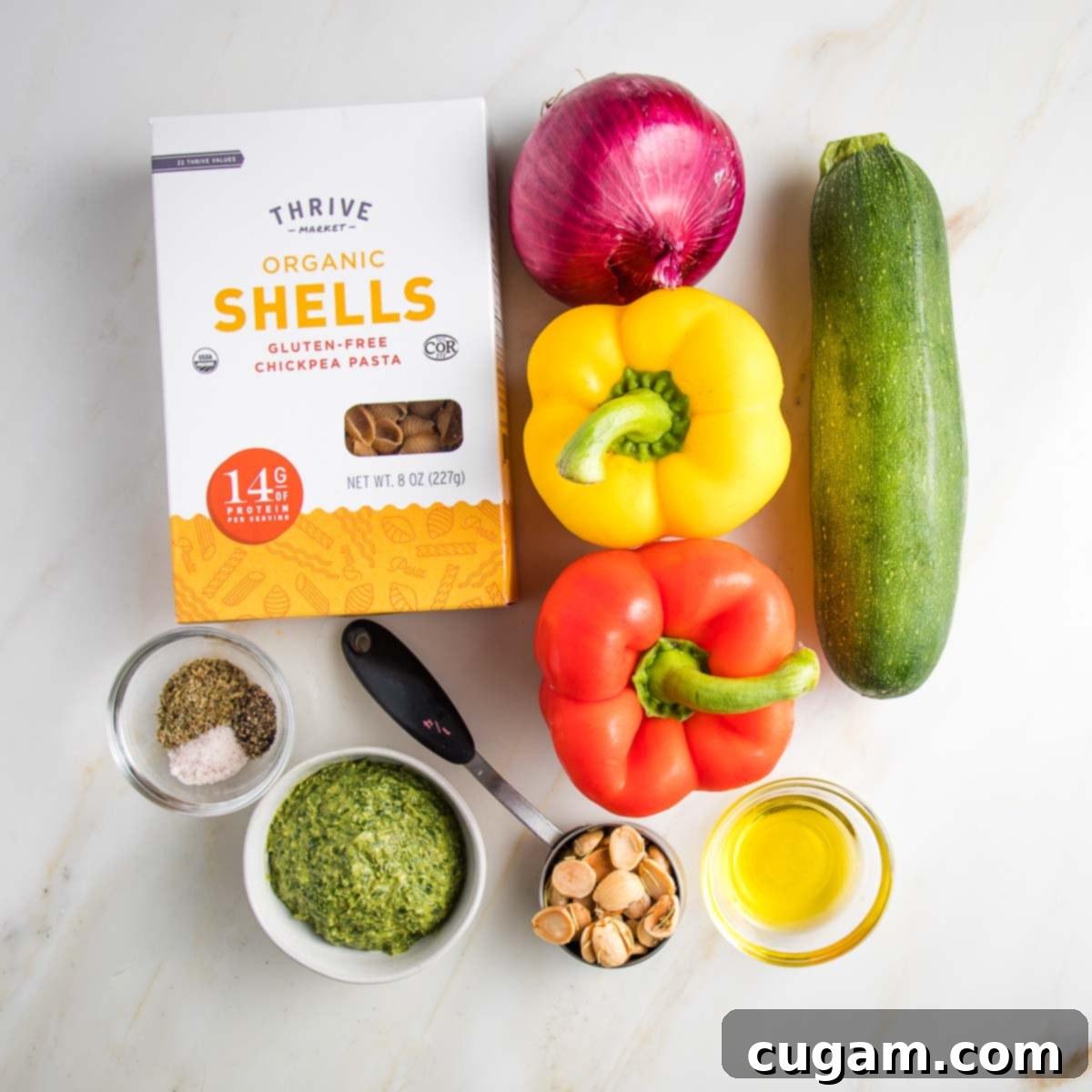
- PASTA: For this recipe, I often use Thrive Market’s gluten-free chickpea pasta, which offers a great texture and added protein. Jovial brand is another excellent choice for gluten-free pasta, known for its quality. However, the beauty of this recipe is its flexibility: any brand or type of pasta will work beautifully – feel free to use your favorite! Short shapes like shells, rotini, penne, or fusilli are ideal as they trap the pesto sauce wonderfully. For an adventurous twist, you can even substitute other grains like orzo, farro, couscous, or millet; while it technically wouldn’t be a “pasta” salad anymore, the resulting grain salad will still be incredibly delicious.
- VEGGIES: The key here is to use what’s fresh, in season, or readily available in your kitchen. I typically opt for a colorful and flavorful assortment of bell peppers (red, yellow, orange), purple onion, and zucchini, as they roast up perfectly and add a lovely sweetness. But don’t limit yourself! Eggplant, cherry tomatoes (added after roasting), asparagus, broccoli florets, or even cauliflower would be fantastic additions. If you love a unique flavor, try fennel and carrots. The more vegetables, the better, in my opinion, ensuring a nutrient-packed and vibrant dish. When ripe tomatoes are abundant, I sometimes make this Summer Pasta Salad base (featuring peas, chickpeas, and spinach) and combine it with this pesto.
- PESTO: This recipe includes a simple yet irresistible recipe for basic dairy-free basil pesto. It’s fresh, garlicky, and vibrant. However, if you’re looking to switch things up or use different greens, many other pesto recipes will work exceptionally well. Consider trying carrot top pesto for a unique earthy flavor, arugula and walnut pesto for a peppery kick, or kale and cashew pesto for a creamier, nuttier texture. Essentially, any combination of fresh greens/herbs, nuts/seeds, garlic, and lemon juice can create a fantastic pesto base.
- NUTS: I’m currently enjoying a moment with Marcona almonds; their delicate crunch and slightly sweeter flavor make them a wonderful topping for this pasta salad. However, you can substitute any nut you love – toast them lightly for an added layer of crunch and enhanced flavor. If you have a nut allergy, seeds are a perfect alternative; sunflower seeds or pepitas (pumpkin seeds) work wonderfully and add great texture.
- OLIVE OIL: A good quality extra virgin olive oil is essential for drizzling over the vegetables before roasting, helping them caramelize beautifully and adding rich flavor. For those following an oil-free diet, you can absolutely omit the oil or use a splash of vegetable broth to coat the veggies instead.
- SPICES: My go-to blend for roasting vegetables includes dried Italian herbs, sea salt, and white pepper, which provides a classic and comforting flavor profile. If you enjoy a bit of heat, don’t hesitate to sprinkle on some crushed red pepper flakes during roasting or just before serving.
How to Create This Delicious Veggie Pesto Pasta Salad
This incredibly easy recipe comes together in under 30 minutes, involving just a few straightforward steps. Multitasking is key here, allowing you to prepare the veggies, pesto, and pasta simultaneously for maximum efficiency.
First, preheat your oven to 425°F (220°C). For the easiest cleanup, line a large, rimmed baking tray with parchment paper.
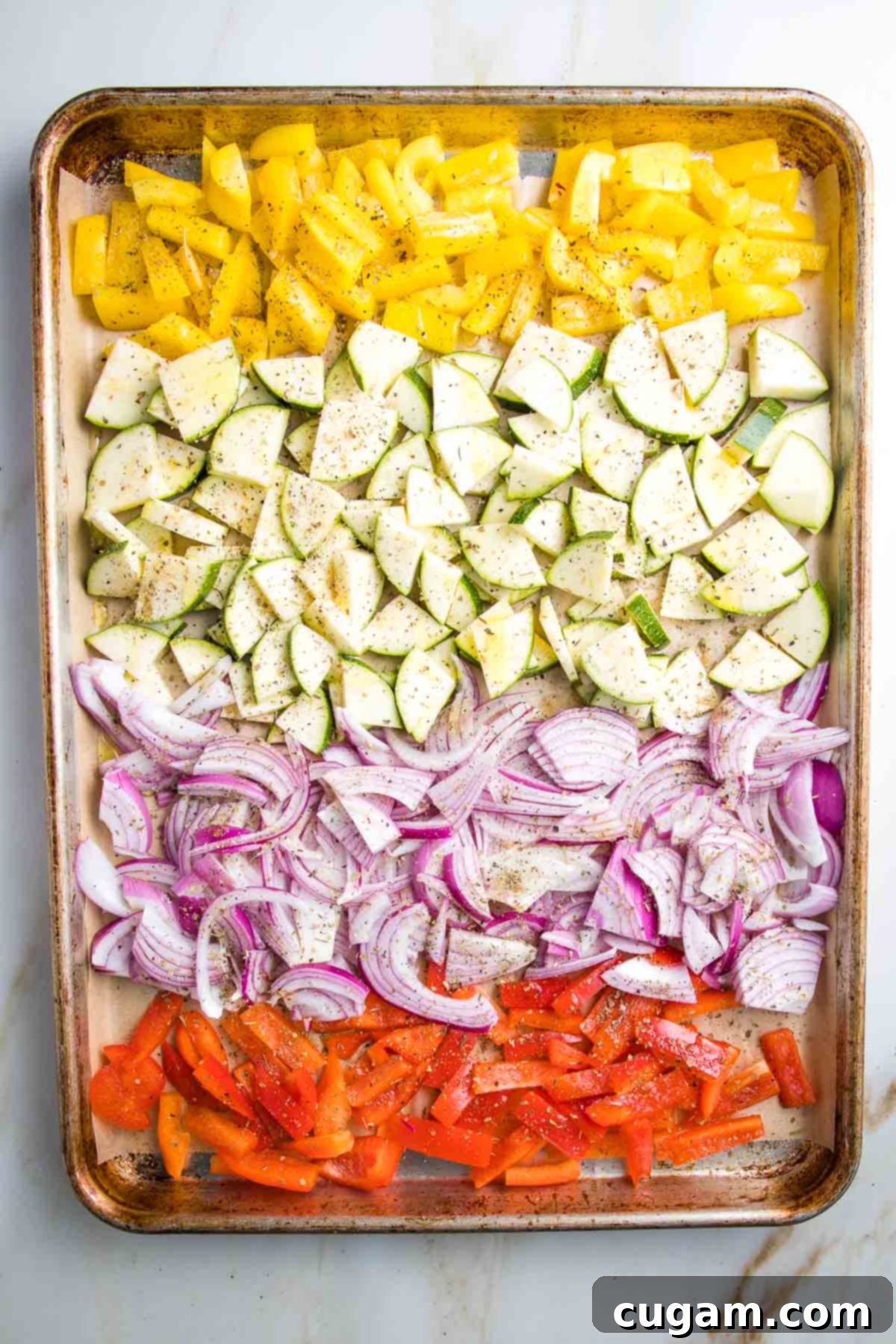
Prepare the Vegetables: Cut all your chosen vegetables into uniform, bite-sized pieces. This ensures they cook evenly and are easy to eat in the salad. Arrange them in a single layer on your prepared baking tray. Drizzle generously with olive oil and then season with Italian seasoning, salt, and freshly ground pepper. Toss gently to ensure all pieces are coated.
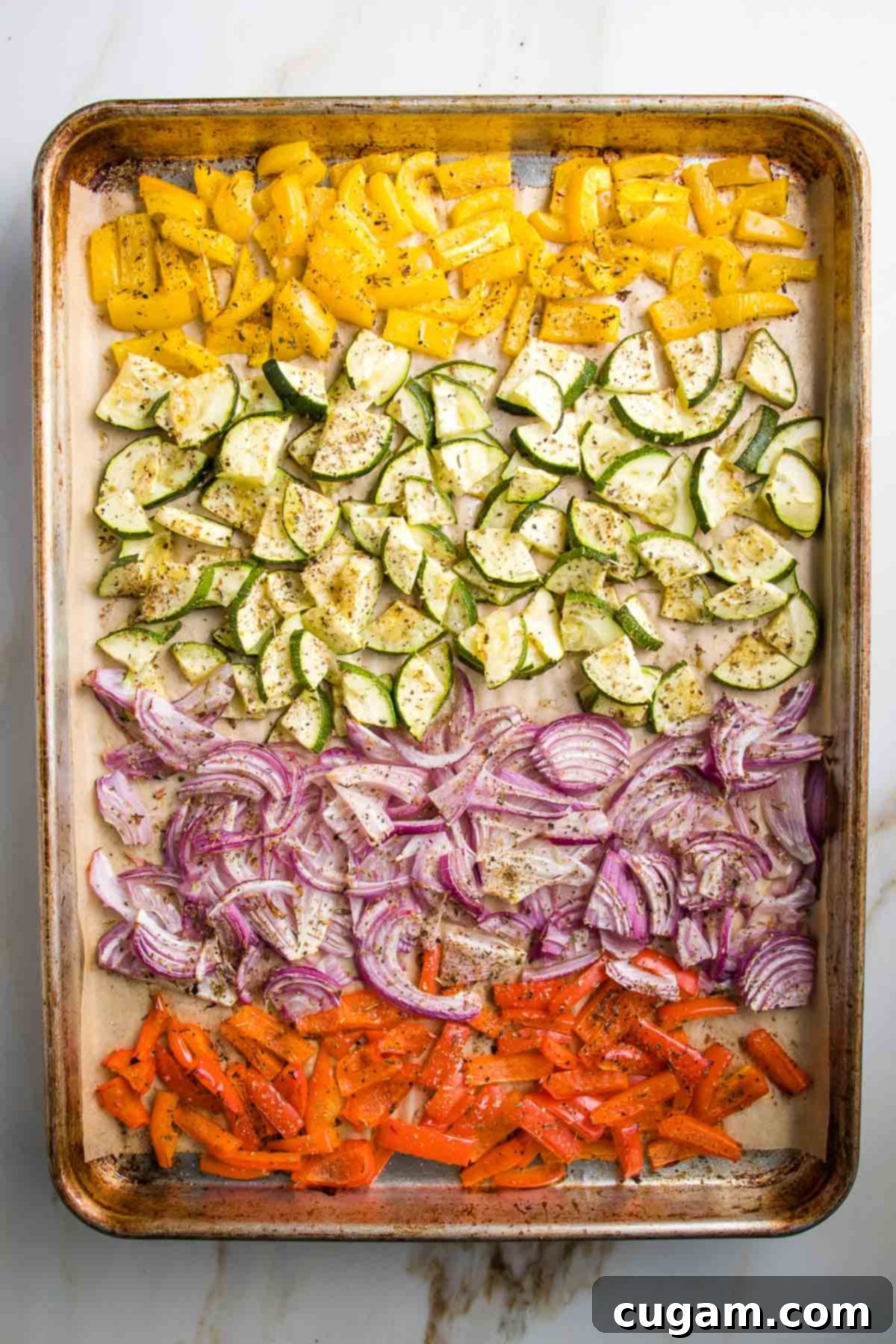
Roast the Veggies: Place the tray in your preheated oven and roast for approximately 15 minutes, or until the vegetables are tender-crisp and slightly caramelized. While the vegetables are roasting, you’ll have ample time to prepare the pesto and cook your pasta, streamlining the entire process.
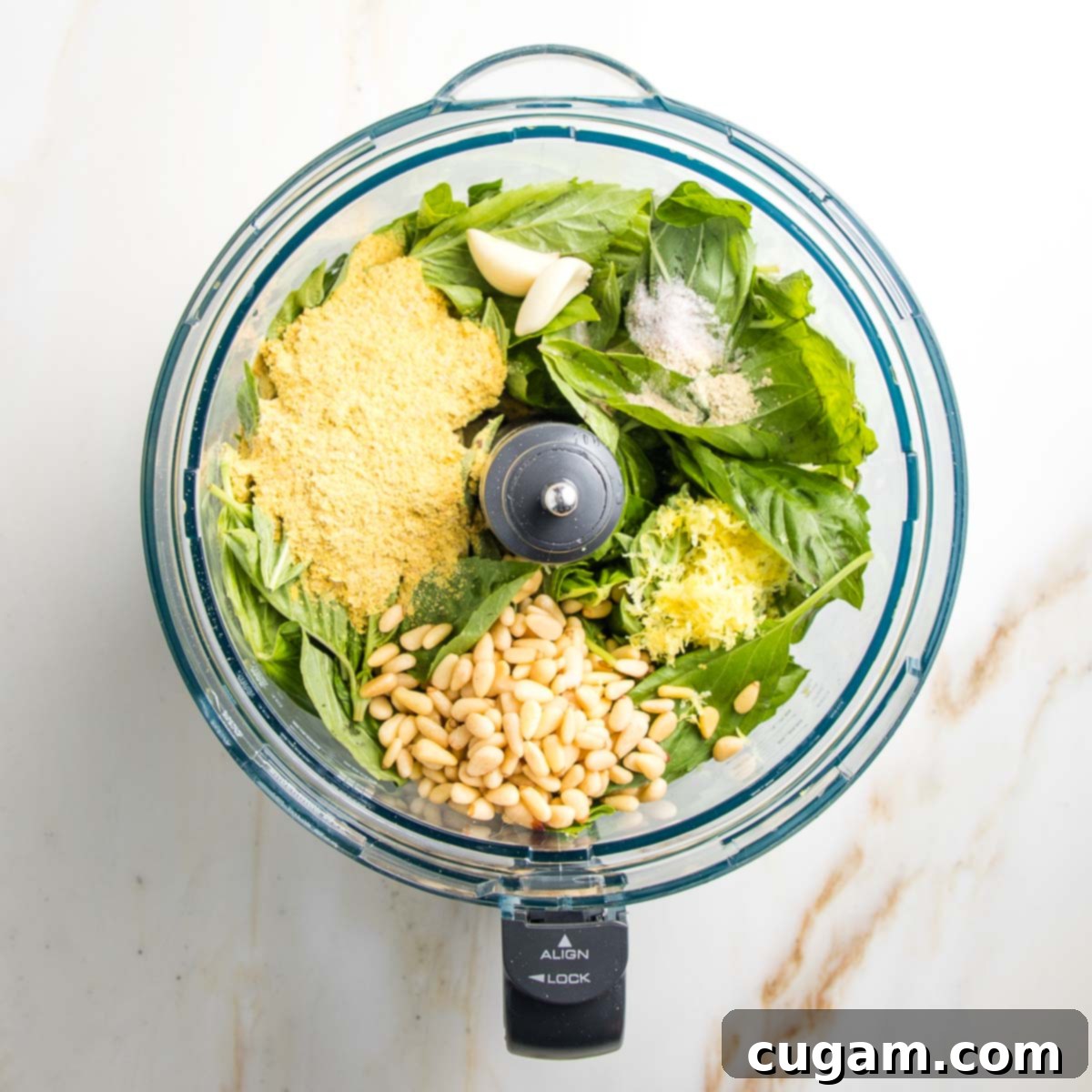
Make the Pesto: I prefer using my food processor for making pesto, but a high-speed blender also works well. Combine all pesto ingredients except the olive oil and water. Process until well chopped, then, with the machine running, slowly drizzle in the olive oil and water (or just water/veggie broth for an oil-free option) until you achieve a smooth and creamy consistency. Scrape down the sides of the bowl as needed to ensure everything is incorporated.
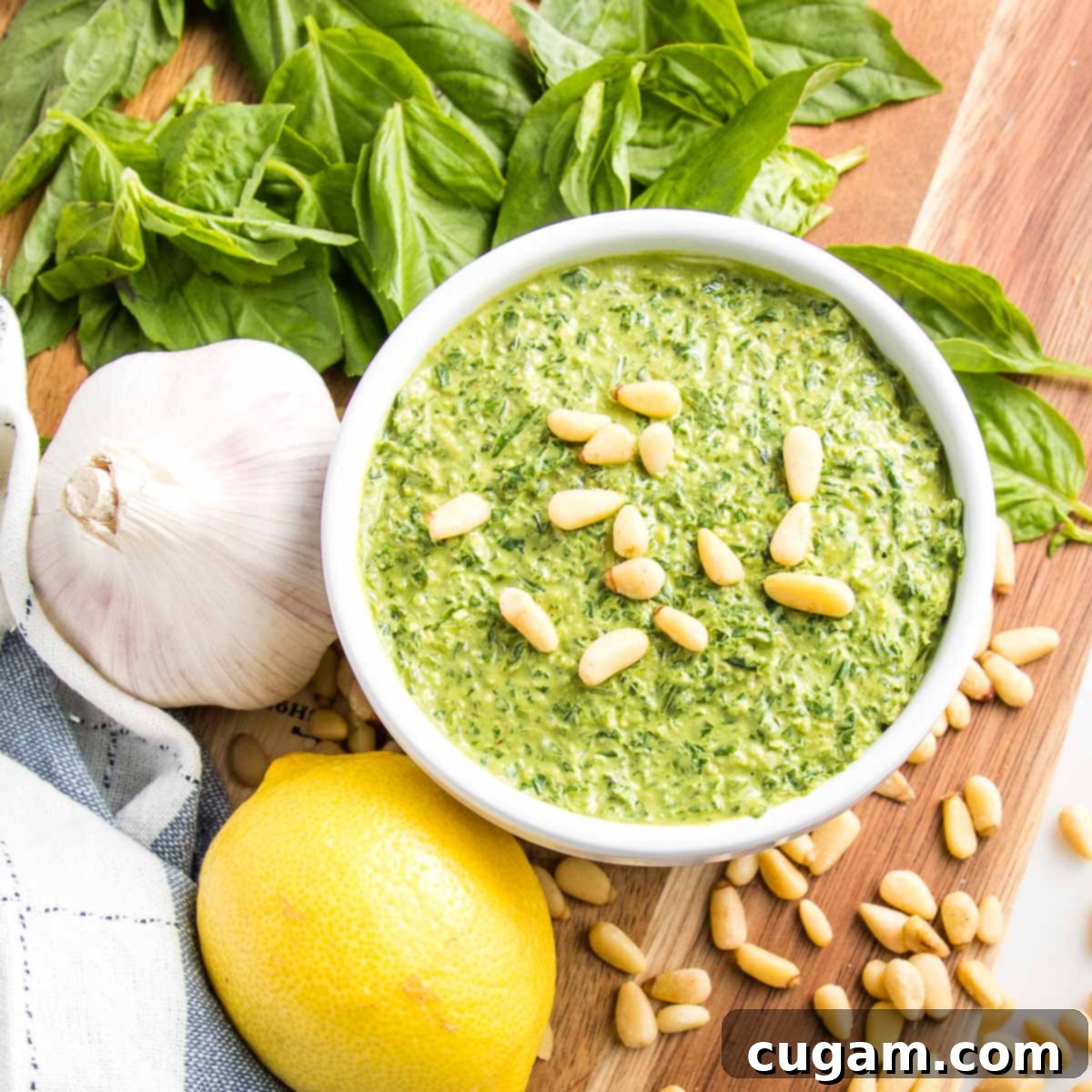
You have the flexibility to adjust the liquid ratio in your pesto. For a truly oil-free pesto, you can use all water or vegetable broth instead of olive oil. The key is to achieve a pourable consistency that will beautifully coat your pasta. Set your freshly made pesto aside, ready for assembly.
Pro Tip on Cooking Gluten-Free Pasta
When cooking gluten-free pasta, always follow the package directions, but with a slight modification: start checking for doneness 1-2 minutes earlier than the suggested cooking time. Gluten-free pasta can go from al dente to mushy quite quickly. Additionally, I highly recommend adding a pinch of salt to your pasta water. This not only seasons the pasta from the inside out but also helps the water boil at a slightly higher temperature, which is ideal for achieving perfectly cooked pasta with a pleasant texture.
Once your pasta is cooked, it’s crucial to save some of the starchy pasta water. You’ll need approximately ½ cup of this liquid to whisk together with ½ cup of your freshly made pesto. This pasta water helps to thin out the pesto, transforming it into a silky, pourable sauce that clings beautifully to every strand of pasta. Depending on the thickness of your pesto, you might need a bit more or less water. Start with ¼ cup of water and gradually add more, 1 tablespoon at a time, until you reach your desired consistency. Don’t make the mistake of draining all the water before scooping out a cup – I often use a Pyrex measuring cup to easily scoop it directly from the pot before draining.

Now, with all your components prepped and ready – perfectly cooked pasta, vibrant pesto sauce, and tender roasted vegetables – you’re all set to assemble your stunning pasta salad!
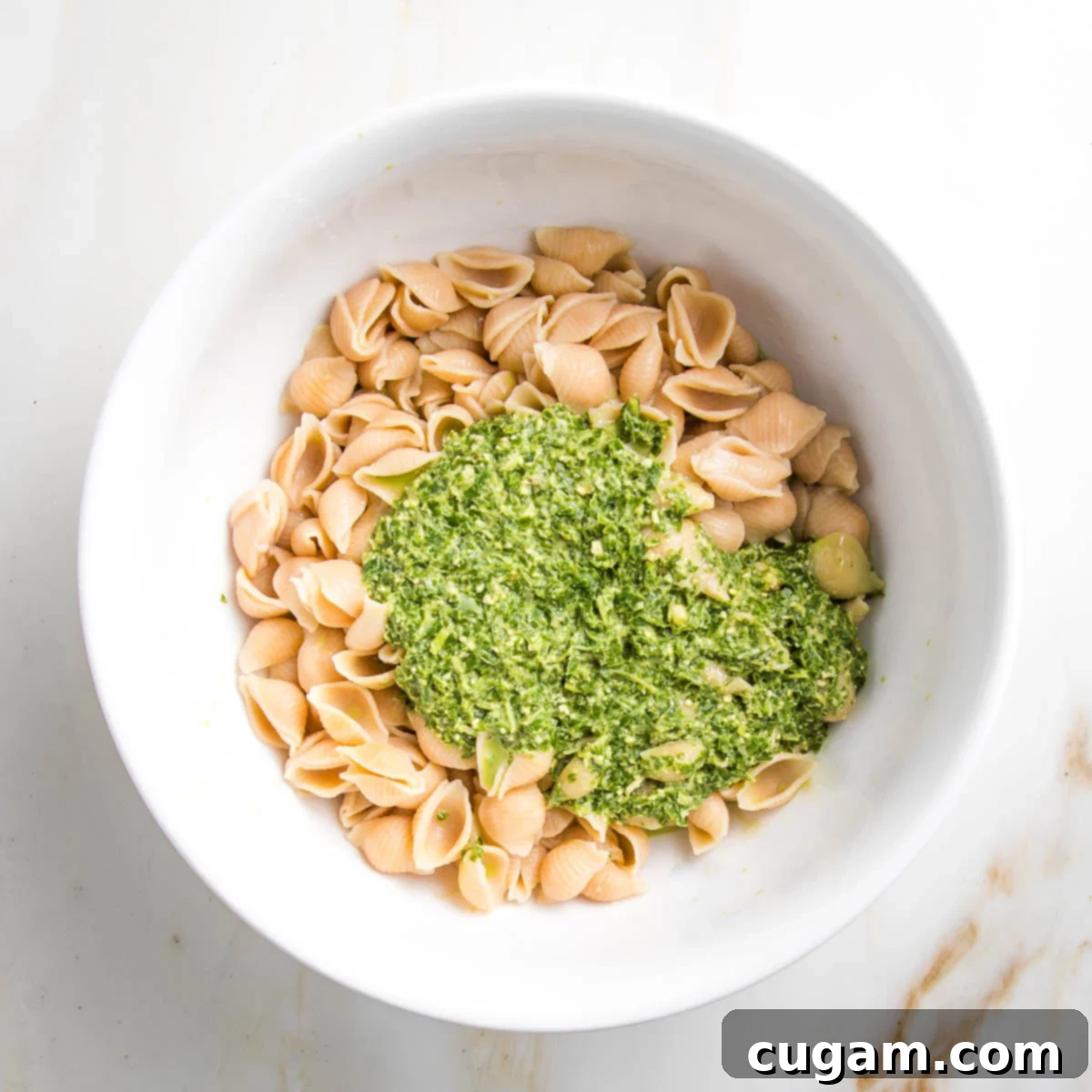
Combine Pasta & Pesto: Transfer your cooked and drained pasta to a large mixing bowl. Pour the pesto, which has been thinned with the pasta cooking water, directly over the pasta. The warmth of the pasta will help the sauce adhere beautifully.
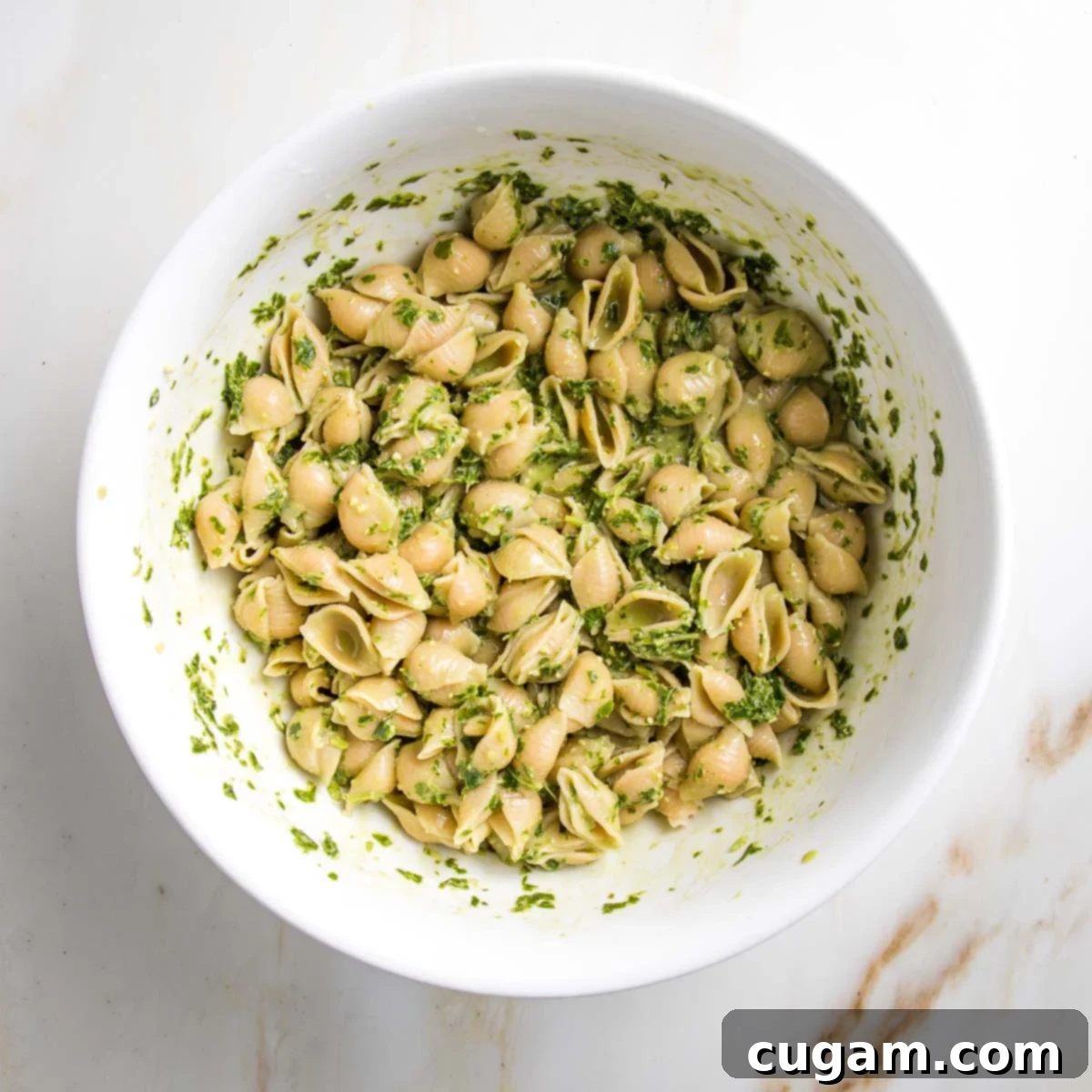
Coat Thoroughly: Using a large spoon or tongs, mix everything together thoroughly. Ensure that every single piece of pasta is beautifully coated in the vibrant, aromatic pesto sauce. This step is crucial for an even distribution of flavor.
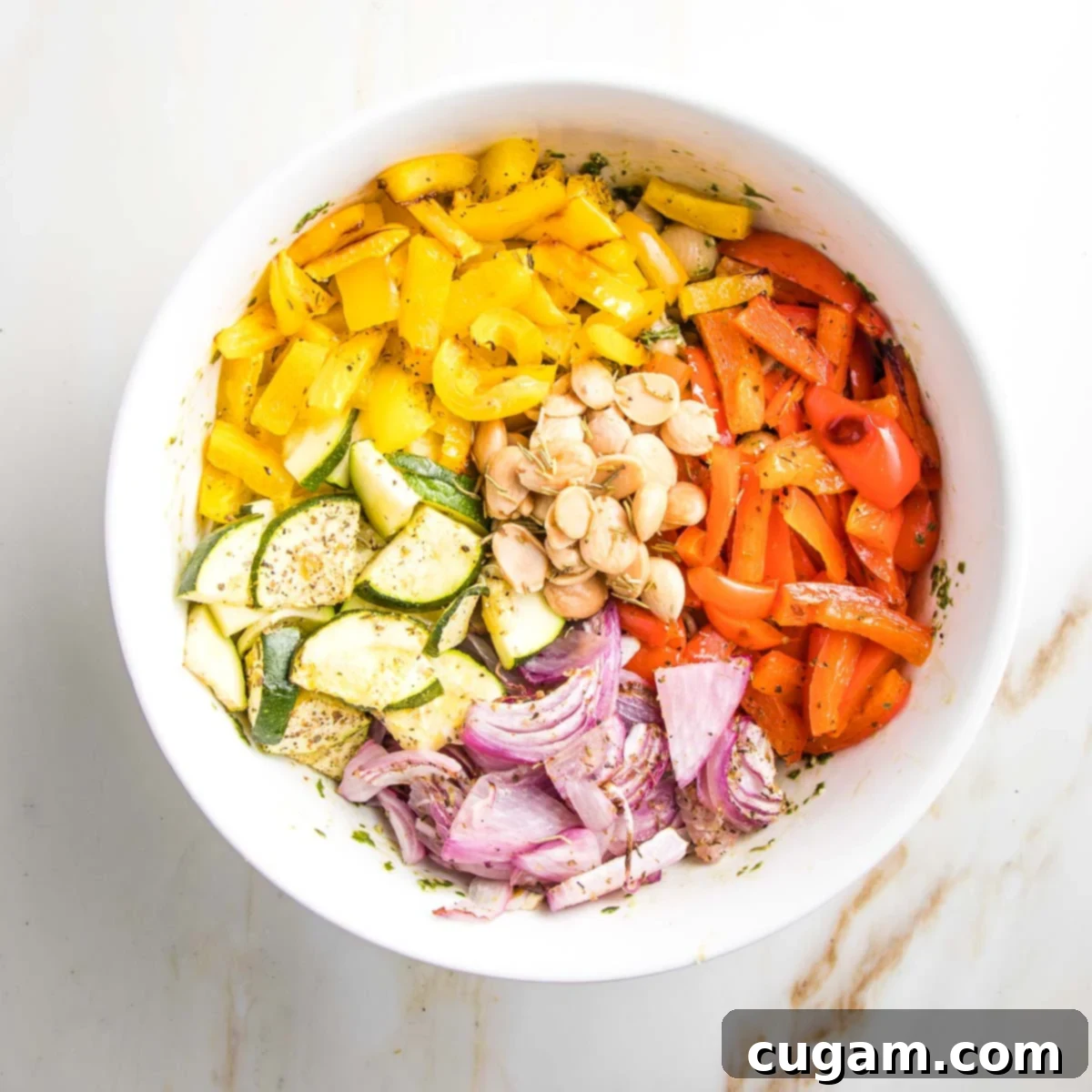
Add Veggies & Toppings: Gently fold in your tender, roasted vegetables. At this point, you can also add any nuts or seeds you desire, such as the Marcona almonds, for an extra layer of crunch and healthy fats. Their texture complements the soft pasta and tender veggies perfectly.
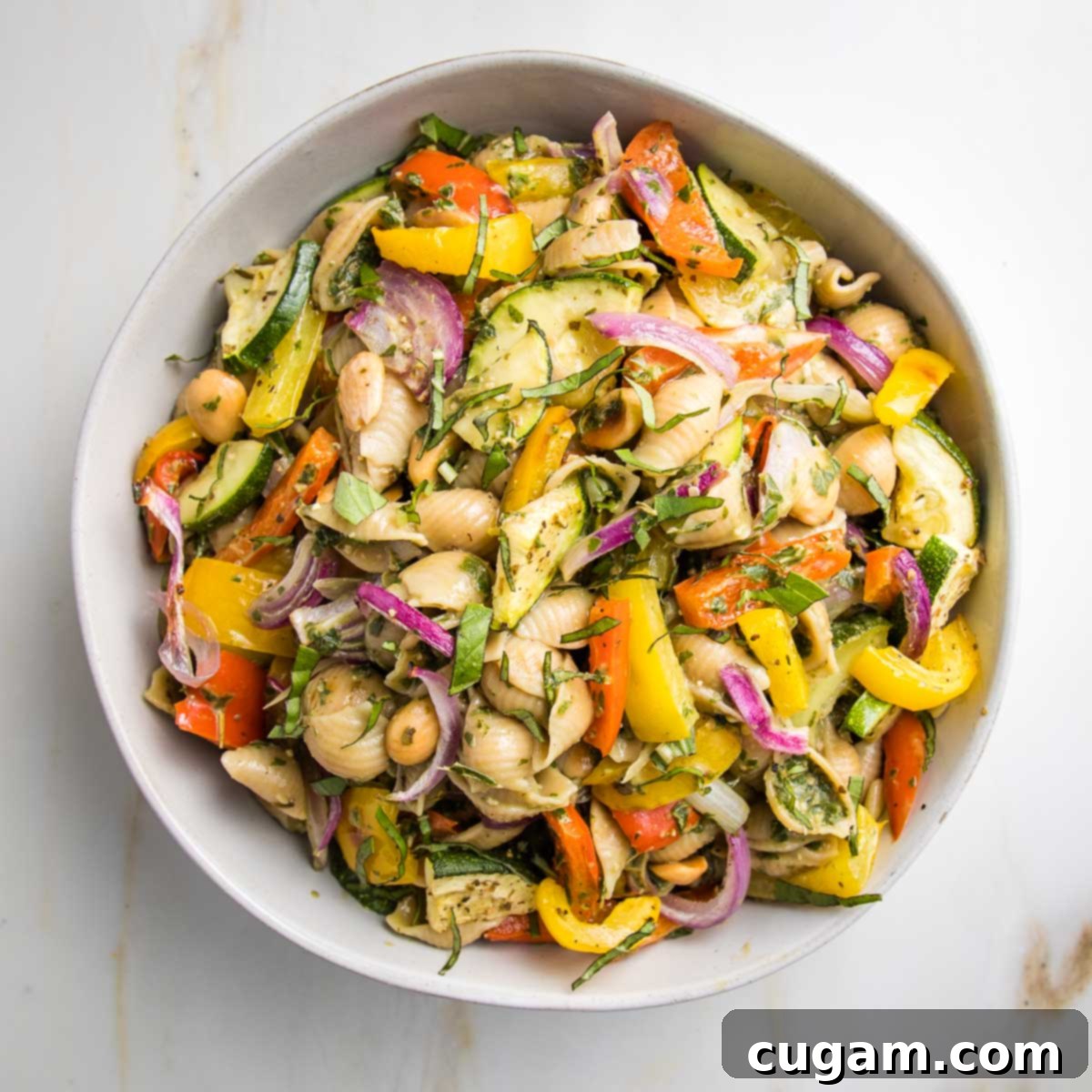
Final Seasoning & Serve: Mix everything well once more to ensure an even distribution. Taste for seasoning and adjust with additional salt and pepper as desired. For an extra flourish, consider a sprinkle of nutritional yeast for a cheesy flavor, or some chopped fresh herbs like basil, parsley, or oregano. You can also add a pinch of crushed red pepper for a subtle kick. And just like that – bam – you’re done! And it’s all been accomplished in less than 30 minutes. This versatile dish can be enjoyed warm, cold, or at room temperature, making it incredibly flexible for any meal or gathering.
Debra’s Expert Tips for the Best Pesto Pasta Salad
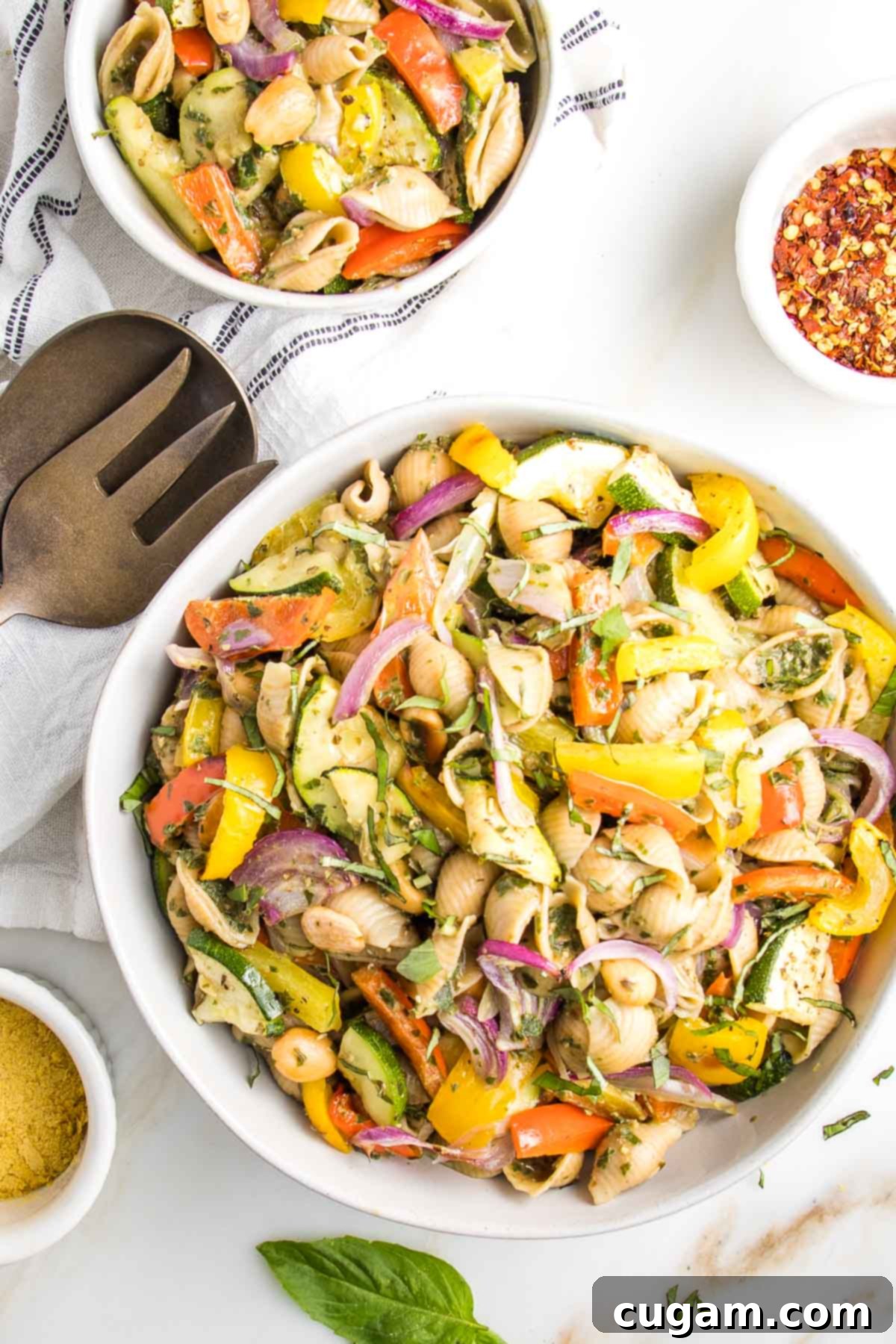
- Pesto Prep Ahead: To save even more time on the day of, prepare your pesto in advance. You’ll only need about ½ cup for this pasta salad. Store the remaining pesto in an airtight container in the fridge, topping with a thin layer of olive oil to prevent browning. Use it later to top some zucchini pizza bites, spread on sandwiches, or toss with other dishes.
- Time-Saving Shortcuts: If you’re really short on time, don’t hesitate to take advantage of store-bought shortcuts. Purchase a good quality already-made pesto (ensure it’s dairy-free if preferred) or look for pre-cut vegetables in the produce section of your grocery store. Every little bit helps!
- Amp Up the Heat: For those who love a bit of a spicy kick, generously sprinkle on some crushed red pepper flakes either during the assembly process or as a garnish before serving. It adds a wonderful warmth that complements the fresh pesto.
- Fresh Herb Boost: Fresh herbs always elevate a dish. If you have any extra fresh basil, oregano, parsley, or thyme on hand, finely chop them and sprinkle them over the finished pasta salad. Their aromatic notes will brighten the entire dish.
- Cool Kitchen Option: Too hot to turn on the oven? No problem! Instead of roasting, grill your vegetables for a smoky flavor. Alternatively, repurpose leftover cooked veggie side dishes from another meal. This makes the salad even quicker and prevents food waste.
- Utilize Leftover Roasted Veggies: Speaking of leftovers, consider making a double batch of delicious oven-roasted broccoli (or any other favorite vegetable) another night. These extra veggies can be added to your pesto pasta salad for an amazingly delicious and convenient meal.
- Pesto Variations Galore: No fresh basil for a traditional pesto? Don’t fret! You can achieve perfect results by making other pesto varieties. Try arugula pesto for a peppery note, carrot top pesto for a unique herbaceous flavor, or kale pesto for a nutrient-dense, slightly earthy version.
- Don’t Forget the Pasta Water! This is a game-changer for pasta sauces! The starchy pasta water emulsifies with the pesto, creating a smooth, luscious sauce that truly coats the pasta beautifully. But if you do accidentally forget to save some (it happens to the best of us!), whisk in a bit of warm vegetable broth to the pesto to achieve a similar, rich consistency for your pasta salad sauce.
Frequently Asked Questions About Pesto Pasta Salad
While pesto pasta can certainly be enjoyed warm or at room temperature, pesto pasta salad is most often served chilled. The cooling process allows the flavors of the pesto and roasted vegetables to meld beautifully, often intensifying their taste. This Pesto Pasta Salad with Roasted Veggies stores wonderfully in the refrigerator for up to 5 days, and it tastes absolutely fantastic straight from the fridge, making it a perfect make-ahead dish.
Transforming a pasta salad into a truly healthy meal is simpler than you might think! The key is to increase its nutrient density and opt for fresh, wholesome ingredients. Here’s how:
- Load Up on Veggies: Significantly increase the proportion of vegetables to pasta. Roasting or grilling vegetables like bell peppers, zucchini, broccoli, or asparagus adds incredible flavor and nutrients.
- Choose a Healthier Sauce: Ditch the mayonnaise-based dressings, which can be high in saturated fats, and opt for a lighter, more vibrant sauce like pesto. Our dairy-free pesto recipe is packed with fresh herbs, healthy fats from nuts, and bright lemon flavor.
- Select Whole Grain or Legume Pasta: Instead of refined white pasta, choose whole wheat, chickpea, or lentil-based pastas. These offer more fiber and protein, keeping you feeling fuller for longer.
- Incorporate Protein & Healthy Fats: Add plant-based proteins like chickpeas, white beans, or edamame. Include healthy fats from nuts (like Marcona almonds, walnuts, pine nuts) or seeds (sunflower, pumpkin) for satiety and texture.
- Make it from Scratch: By preparing your pasta salad from scratch, you gain complete control over the ingredients. This allows you to avoid processed items, excess sugars, and unhealthy oils, ensuring your salad is made with the freshest, most wholesome components.
By following these tips, your pasta salad won’t just be tasty; it will be a powerhouse of nutrition!
Explore More Easy & Delicious Vegan Pasta Recipes
- Easy Summer Pasta Salad
- Cold Sesame Noodles with Tahini
- Vegan Pasta Primavera
- Vegan Bolognese + Spaghetti Squash
Did you know commenting and rating recipes is one of the best ways to support your favorite food bloggers? If you made this recipe, please consider leaving a five-star rating below and a comment sharing your experience. Also, we’d love to see your creations! Please share your photos on Instagram by tagging me @dkhealthcoach and using the hashtag #debraklein. Your support means the world!
📖 Recipe
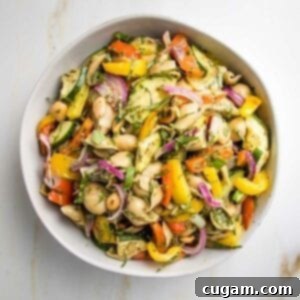
Pesto Pasta Salad with Roasted Vegetables
Rate this Recipe
Pin Recipe
Equipment
-
Sauce Pan with Lid
-
Silicone spatula
-
Food Processor
-
Parchment Baking Paper
-
Half Sheet Baking Pans
Ingredients
- 1 8-oz. package pasta*
- ½ cup pasta cooking water
- ½ cup pesto*
- 1 large zucchini, chopped
- 1 red bell pepper, chopped
- 1 yellow bell pepper, chopped
- 1 purple onion, chopped
- 1 Tablespoon olive oil, for roasting
- 1 teaspoon Italian seasoning
- ½ teaspoon sea salt, for roasting
- ¼ teaspoon black pepper, for roasting
- ¼ cup marcona almonds*, or other nuts/seeds for topping
Basic Dairy-free Basil Pesto (makes 1 cup)
- 3 cups fresh basil leaves, packed
- ½ cup pine nuts
- ¼ cup nutritional yeast
- 2 large cloves garlic
- 1 lemon zested and juiced
- ½ teaspoon sea salt
- ½ teaspoon white pepper
- ¼ cup olive oil*, or less for oil-free
- 2-4 Tablespoons water*, or veggie broth
Instructions
-
Preheat your oven to 425°F (220°C) to get started on the roasted vegetables.
-
Line a large, rimmed baking sheet with unbleached parchment paper. This will ensure easy cleanup and prevent sticking.
-
Chop all your chosen vegetables into uniform, bite-sized pieces and spread them evenly in a single layer on the prepared baking sheet.
-
Drizzle the chopped veggies with olive oil and sprinkle generously with Italian seasoning, sea salt, and black pepper. Toss gently to coat. Roast the seasoned vegetables in the preheated oven for about 15 minutes, or until tender-crisp and slightly caramelized.
-
While the vegetables roast, prepare the pesto: Combine all pesto ingredients (fresh basil, pine nuts, nutritional yeast, garlic, lemon zest, lemon juice, sea salt, white pepper) in the bowl of a food processor. Process until well chopped. You will need about ½ cup of liquid for this recipe, using a combination of olive oil and water (or vegetable broth if making it oil-free). With the food processor running, slowly pour in your chosen liquid until the pesto is smooth and creamy. Stop occasionally to scrape down the sides of the bowl to ensure everything is fully incorporated. Set the vibrant pesto aside.
-
Cook the pasta according to the package directions. For gluten-free pasta, it’s often best to reduce the cooking time by 1 minute to prevent it from becoming too soft. For example, my chickpea pasta was perfect after 8 minutes of boiling. Remember to salt your pasta water!
-
Before draining your pasta, remember to scoop out and save ½ cup of the starchy pasta cooking water. Once saved, drain the remaining pasta and rinse it under cool water to stop the cooking process and prevent it from sticking together.
-
In a small bowl, whisk together the saved ½ cup of pasta water with ½ cup of your prepared pesto. This creates a smooth, pourable sauce that will beautifully coat your pasta.
-
Transfer the drained and cooled pasta to a large mixing bowl. Pour the pesto sauce over the pasta and mix thoroughly until all the pasta is evenly coated. Add the roasted vegetables and any desired nuts or seeds (like Marcona almonds) and toss well to combine all ingredients. Taste the salad for seasoning, adding more salt and pepper as needed. For an extra touch, sprinkle with fresh herbs, nutritional yeast, or a pinch of crushed red pepper, if desired, before serving.
-
This versatile Pesto Pasta Salad can be served warm, cold, or at room temperature, making it perfect for any occasion.
-
Store any leftover pasta salad in an airtight container in the fridge for up to 5 days. The flavors often deepen and improve with time!
Notes
NUTS: If you have nut allergies, sunflower seeds or pumpkin seeds are fantastic substitutes for Marcona almonds, providing a similar crunch and flavor. For those who enjoy nuts, toasted pine nuts, walnuts, or pistachios are also delicious additions.
PESTO: You can use the basic dairy-free basil pesto recipe provided here, or get creative with other pesto variations. Carrot Top Pesto, Kale + Cashew Pesto, or Arugula and Walnut Pesto are all excellent choices that will work wonderfully with this pasta salad.
NUTRITION INFO: Please note that the nutrition information provided at the bottom of this recipe is calculated based on the full pesto recipe yield (1 cup). However, you only need approximately ½ cup of the pesto for the pasta salad itself. Therefore, the actual nutrition per serving of the pasta salad will be slightly lower than indicated, as it accounts for the full pesto batch.
Nutrition
Note
The nutrition calculations were done using online tools. To obtain the most accurate representation of the nutritional information in any given recipe, you should calculate the nutritional information with the actual ingredients you used. You are ultimately responsible for ensuring that any nutritional information is accurate, complete and useful.
More Easy Vegan Potluck Recipes You Will Adore
- Zesty Mexican Street Corn Salad
- Hearty Southwest Quinoa Salad
- Healthy Grain-Free Peanut Butter Cookies
- Refreshing Raw Cauliflower Salad with Lime
- Flavorful Oven-Roasted Mexican Cauli-Rice
- Wholesome Healthy Zucchini Bread
